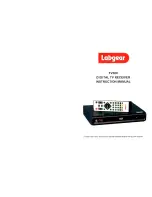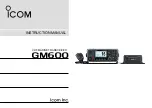
3 - 3
3-2 TRANSMITTER CIRCUITS
MAIN UNIT
The MAIN UNIT contains transmit circuits; from MIC AMP to
modulator cicuit.
• TX AF CIRCUITS
The audio signals from the microphone (MIC signals)
are amplified by MIC AMP (IC171) and level-adjusted by
VCA (IC171). The level-adjusted MIC signals are passed
through the MIC mute SW (IC201) and MIC line selector
(IC211) which selects the MIC line; MIC signals from the
microphone jack on the FRONT UNIT, or from [ACC1]
socket on the MAIN UNIT.
The MIC signals are then applied to the limiter AMP (IC221)
which limits the amplitude of MIC signals. The amplitude-
limited MIC signals are applied to the ADC (IC1251) via the
unbalance-balance convert circuit (IC1311, 1321, 1331),
to be converted into the 24-bit serial data. The serial data
is applied to the DSP (IC1001) and processed as digital
audio signals. The processed digital audio signals are then
applied to the Digital to Analog Converter (DAC; IC1501) to
be converted into the analog audio signals; as the 36 kHz
1st TX IF signal. The 1st TX IF signal is entered to the RF
UNIT.
RF UNIT
RF UNIT contains transmit circuits; TX mixers and AMPs.
The 36 kHz 1st TX IF signal from the MAIN UNIT is applied
to the 1st TX mixer (IC503) to be mixed with the 491 kHz
3rd LO signal from the PLL UNIT, to be converted into
the 455 kHz 2nd TX IF signal. The converted 2nd TX IF is
amplified by the 2nd IF AMP (Q501), filtered by 2nd TX IF
filter (FI1501 for BW=20 kHz or FI1502 for BW=4 kHz). The
filtered 2nd TX signal is amplified by 2nd IF AMP (Q504),
and applied to the 2nd TX mixer (D505) to be mixed with the
64 MHz 2nd LO signal from the PLL UNIT, to be converted
into the 64.455 MHz 3rd TX IF signal. The converted 3rd
TX IF signal is passed through the BPF (FI503), amplified
by 3rd IF AMP (Q506), and filtered by the LPF. The filtered
3rd TX IF signal is applied to the 3rd TX mixer (D506) to
be mixed with the 3rd LO signal from the PLL UNIT, to
be converted into the 4th TX IF signal (=TX signal). The
converted TX signal is filtered by the LPF, amplified by RF
AMP (Q508), passed through one of BPFs, then applied to
the YGR AMP (Q801).
The amplified TX signal is entered to the PA200W BOARD.
PA200W BOARD
• TX AMPLIFIERS
The TX signal from the RF UNIT is amplified by the RF AMP
(Q101), Pre-drive (Q201), drive (Q301) and power (Q401A,
B) amplifiers in sequence, to obtain TX output power. The
power-amplified TX signal is entered to the FILTER UNIT.
FILTER UNIT
• TX FILTERS
The power-amplified TX signal from the PA200W BOARD
is passed through one of BPFs (according to the TX
frequency) to remove unwanted signals including harmonic
components. The filtered TX signal is then entered to the
CTRL BOARD.
CTRL BOARD
The CTRL BOARD mainly contains circuits for parameter
detection of TX signal; Forward Wave, Reflected wave,
Reactance, Resistance, antenna current and voltage.
TX signal from the FILTER UNIT is passed through several
detection circuits in sequence, then applied to the antenna
[ANT1]–[ANT4].
• FOR (Forward Wave) voltage detection circuit
A portion of TX signal is rectified by current trans (L101) and
diode (D102), and the produced DC voltage is composed
by C103, C106 and C116 to detect FOR voltage (Forward
wave components). The detected voltage is amplified by
IC101 and applied to the A/D port of CPU (IC1).
• REF (Reflected Wave) voltage detection circuit
A portion of TX signal is rectified by current trans (L101) and
diode (D101), and the produced DC voltage is composed by
C102, C105, C115, C120 and C121 to detect REF voltage
(Reflected wave components). The detected voltage is
amplified by IC101 and applied to the A/D port of CPU (IC1).
• Reactance components detection circuit
A portion of TX signal which is detected by current trans
(L151) and TX signal which is divided by C153 and C158
are amplified by C-MOS IC. This AMP, as the first stage,
employs a C-MOS type AMP to detect the low TX signal.
The inverter AMP requires input level lower than others
need, and provides high speed operation for stable high
frequency operation with low TX signal.
The amplified signal is adjusted its waveform, then applied
to the IC155 and IC156 for phase comparison. The output
signal is rectified by D153 and D154, composed and
amplified by IC201, then applied to the A/D port of the CPU
(IC1).
• Resistance components detection
A portion of TX signal which is detected by current trans
(L201) and TX signal which is divided by C202, C205 and
C206 are adjusted so that two of these are the same on the
voltage. And two of these are rectified composed each other
to detect the resistance components. When the detected
voltage is increased, Q201 is activated to amplify the signal
for high detection sensitivity.










































